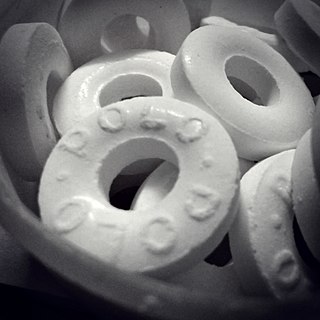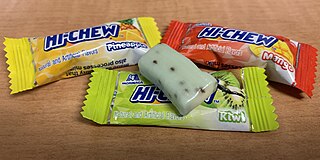This article contains content that is written like an advertisement .(December 2023) |

Chewits is the brand name of a cuboid-shaped, soft chewy sweets manufactured by Cloetta.
This article contains content that is written like an advertisement .(December 2023) |

Chewits is the brand name of a cuboid-shaped, soft chewy sweets manufactured by Cloetta.
The sweets were first produced in 1963 as "Chewzits", manufactured by J A & P Holland in Southport. [1] In 1965, Hollands were acquired by James Goldsmith and amalgamated into Cavenham Foods along with Parkinson's of Doncaster and Carsons & Goodies of Bristol and several other confectionery companies into Cavenham Confectionery, [2] [3] and the name was changed to "Chewits". After the closing of the factory in 2006 manufacturing was moved to Slovakia. [4] [5] Chewits has greatly expanded its line of flavours, however, the original flavours consisted of Strawberry, Blackcurrant, Orange and Banana. Over the years more exotic flavors such as Ice Cream, Cola, Rhubarb & Custard, and Blue Mint were introduced as limited edition flavours. In 2000 [6] sour flavours, [7] Apple and Tutti Frutti were launched, and other fizzy and hot flavours were available for a limited time. New Chewits pack designs, formats and flavours were launched in 2009. Currently, Chewits’ core flavour range includes Strawberry, Blackcurrant, Fruit Salad, Lemon Xtreme, Cola, Blue Raspberry, and Cherry. [8]
Ice Cream Chewits, originally released in 1989, were re-introduced in 2009 following an online petition [9] and demand expressed on Facebook [10] and Bebo. [9]

Chewits was first advertised on television in 1976. The original advertisements featured Chewie the Chewitsaurus, a Godzilla-resembling mascot on the hunt for something chewy to eat. The first ad featuring Chewie threatening New York was made by French Gold Abbott and created by John Clive and Ian Whapshot. The first ad was successful, but the sequel was delayed. Chewie chomps and tramples humorously local and well-known international landmarks such as Barrow-in-Furness Bus Depot, a London block of flats, London Bridge, the Taj Mahal, the Leaning Tower of Pisa, and the Empire State Building. Chewie could only be quelled by a pack of Chewits.
A spin-off computer game, The Muncher, was released for the ZX Spectrum in 1988.
The original adverts used Claymation special effects, similar in style to those made famous in the movies of Ray Harryhausen. They also included a voiceover style reminiscent of a 1950s radio serial.
A subsequent advertisement, originally aired in 1995, plays on the over-the-top advertising style of the post-war era. To the tune of bright 1950s-era orchestration, a sales narrator exhorts viewers to try a variety of chewy consumer items in the essential guide to a chewier chew. The ad shows Chewie sampling items such as Wellington boots, a rubber boat and a rubber plant to be ready for the chewiest of chews - Chewits.
In the late 1990s, Chewits experimented with ads showing multiple newscasting dinosaur puppets. The catchphrase advice at the close of each 'broadcast' was to "do it before you chew it". This style of ads was relatively short-lived for Chewits.
With a change of advertising agencies, the puppets were replaced by colourful 2D animations. Chewie the Chewitsaurus was re-introduced in two popular adverts from this time. In the first, which aired in 1999, Chewie roller skates on two buses through a busy city scene. The second, which went out a year later in 2001, shows Chewie waterskiing at a popular seaside resort. The ads included a rendition of the 1994 hit song 'I Like to Move It' [11] by Reel 2 Real, with the chorus, "I Like to Chewit Chewit."
In 2003, after a further shift in advertising agencies, a new ad was aired showing a wide range of animals auditioning to be the new faces of Chewits. The ad announced the return of the iconic dinosaur Chewie mascot, now dubbed 'Chewie the Chewitsaurus'. [12]
In 2009, Chewits introduced the new Chewie the Chewitsaurus look, showing a contemporary, computer-game-style slick design. [13] Chewie the Chewitsaurus features on all Chewits packaging and sponsorship activity.
In late 2019, a new design was introduced for Chewie, with a mottled paint effect on the colours, and more exaggerated mouth and teeth. [14]
In 2009, Chewits launched a social media campaign with the new-look Chewie the Chewitsaurus. The Facebook page [15] titled “Chewie the Chewitsaurus” and has established over 400,000 ‘likes’ in its lifetime. Copyrighting on the Facebook page [15] is derived from, and reminiscent of the 1950s radio serial narrator style from the previous TV advertising campaigns.
Chewits have been involved in a range of promotional activity over the years including the Chewits log flume at Pleasureland in Southport. More recently, Chewits have sponsored several sport and activity-related programmes for children in the UK.
Chewits Sports Courses, in partnership with children's coaching organisation Premier Sport, run daily during school holidays and provide sporting activity courses to approximately 125,000 children in the UK. [17] The sponsorship is supported by sporting ambassadors Lawrence Dallaglio, Duncan Goodhew and Paul Sculthorpe. [18]
Chewits began sponsoring the Lancashire County Cricket's junior membership club, the Lancashire Thunderbolts, in February 2009. [19]
In 2009, Chewits launched a programme to help young sporting hopefuls ahead of the London Olympics in 2012. The Chewits Young Sporting Ambassador programme provides financial support and coaching to sponsored athletes. [20]
In 2011, Chewits partnered with Team Extreme [21] and held an extreme sports road show to promote the Xtreme range of products.
Chewits subscribes to the Betreatwise program, a UK program that encourages people to think about the treats they eat as a part of a healthy and well balanced diet, and to use the Guideline Daily Amounts (GDAs) on the back of packs for nutritional guidance.
Most flavours of Chewits are approved (but not supervised) for those who keep kosher, as per the London Beth Din's list.[ citation needed ]

Tango is a carbonated soft drink originating in the United Kingdom, primarily sold in the UK and Ireland. It was first launched by Corona in 1950. Corona was purchased by the Beecham Group in 1958, and Corona Soft Drinks by Britvic in 1987.

Spangles was a brand of boiled sweets manufactured by Mars Ltd in the United Kingdom from 1950 to the early 1980s. They were sold in a paper packet with individual sweets originally unwrapped but later cellophane wrapped. They were distinguished by their shape which was a rounded square with a circular depression on each face.

Polo is a brand of breath mint whose defining feature is the hole in the middle. The peppermint flavoured Polo was first manufactured in the United Kingdom in 1948, by employee John Bargewell at the Rowntree's Factory, York, and a range of flavours followed. The name may derive from "polar", referencing the cool, fresh taste of the mint. Polo mints are also sold in other countries such as India and Sri Lanka by Nestlé. Polo mints are usually sold in a 34g pack containing 23 individual mints.

Starburst is the brand name of a box-shaped, fruit-flavoured soft taffy candy manufactured by The Wrigley Company, which is a subsidiary of Mars, Incorporated. Starburst has many different varieties, such as Tropical, Sour, FaveREDs, Watermelon, Very Berry, Superfruit, Summer Blast and Original.

Wine gums are chewy, firm pastille-type sweets originating from the United Kingdom. All brands have their own recipes containing various sweeteners, flavourings and colourings. Wine gums are popular in the United Kingdom, Canada, Ireland, South Africa and many Commonwealth nations, as well as several European countries. Common brands include Maynards, Bassett's, Haribo and Lion.

After Eight Mint Chocolate Thins, often referred to as simply After Eights, are a brand of mint chocolate covered sugar confectionery. They were created by Rowntree Company Limited in the UK in 1962 and have been manufactured by Nestlé since its acquisition of Rowntree in 1988.

Airheads is an American brand of the taffy candy owned by the Italian-Dutch company Perfetti Van Melle. They were created on August 7, 1985, by Steve Bruner. Airheads are available nationwide in the United States and Canada where the candy is available in 16 different flavors.

Quality Street is a line of tinned and boxed toffees, chocolates and sweets, first manufactured in 1936 by Mackintosh's in Halifax, West Yorkshire, England. It was named after J. M. Barrie's play Quality Street. Since 1988, the confectionery has been produced by Nestlé. Quality Street has long been a competitor to Cadbury Roses, which were launched by Cadbury in 1938. Nestlé does not distribute Quality Street in the US, but it may be ordered online for delivery, or found in specialty candy shops.

Rowntree's Fruit Pastilles are small round sweets measuring about 1.5 cm (0.6 in) in diameter; they have a jelly-like consistency, and are covered with sugar. They contain fruit juice, have no artificial colours or flavours, and come in five flavours: lemon (yellow), lime (green), strawberry (red), blackcurrant (purple) and orange (orange).

Fry's Chocolate Cream is a chocolate bar developed by J. S. Fry & Sons and currently manufactured by Cadbury. Launched in 1866—nineteen years after Fry's created the first moulded, solid chocolate eating bar — Fry's Chocolate Cream is the first mass-produced chocolate bar and is the world's oldest chocolate bar brand.

Hi-Chew is a Japanese fruit candy sold by Morinaga & Company.
Fruit-tella are chewy sweets similar to Sugus, Starburst and Chewits. They are made using real fruit juice, natural colours and natural flavours, sugar and gelatine. They are made by Perfetti Van Melle, the company that also manufactures Mentos and Chupa Chups.

Swizzels Matlow Limited, branded as Swizzels, is a confectionery manufacturer based in New Mills, Derbyshire, near Stockport in the United Kingdom. The company had revenues of £47 million in 2010/11. It employs around 600 people. Swizzels Matlow exports 20 per cent of its sweets to more than 20 countries, mostly in Europe. Their highest selling brands are Love Hearts, Parma Violets and Drumstick lollies. Its biggest sales period is Halloween.

Percy Pig is a British brand of pig-shaped gummy raspberry, strawberry, cherry and grape-flavoured confectionery products made under licence in Germany by Katjes for Marks & Spencer which first appeared in stores in 1992. More than £10 million was grossed between June 2009 and 2010 in Percy Pig sales in Marks & Spencer's UK branches alone. They contain just under 3.5% fruit juice and since May 2022 have been suitable for vegans.
The Wham Bar is a confectionery bar produced by Tangerine Confectionery and sold in the United Kingdom and the Republic of Ireland.

Gummies, gummi candies, gummy candies, or jelly sweets are a broad category of gelatin-based chewable sweets. Gummy bears, Sour Patch Kids, and Jelly Babies are widely popular and are a well-known part of the sweets industry. Gummies are available in a wide variety of shapes, most commonly seen as colorful depictions of living things such as bears, babies, or worms. Various brands such as Bassett's, Haribo, Albanese, Betty Crocker, Hersheys, Disney and Kellogg's manufacture various forms of gummy snacks, often targeted at young children. The name "gummi" originated in Germany, with the term "jelly sweets" more common in the United Kingdom.

Rowntree's Randoms are a jelly sweet produced by Nestlé under its Rowntree's brand. The sweet was launched in the UK on 18 May 2009.
Cresta was a frothy fruit-flavoured drink produced in the United Kingdom by Schweppes from the early 1970s through to the early 1980's. It originally came in four different flavours: strawberry, lemon & lime, pineapple and orange; blackcurrant & Cream Soda were added later.

Mynthon is a Finnish brand of pastilles owned by Cloetta. It has been produced since the 1970s. Mynthon is the best selling brand of pastilles in Finland with a market share of about 30%: its annual sales are about 22 million items. As well as Finland, Mynthon is sold in the Baltic countries, Sweden and Norway. Mynthon is considered an icon of refreshment. The pastilles are especially used to relieve a sore throat.